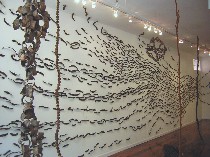 How nature regenerates over and over again in the Amazon jungle of Guyana and the concrete jungle of Philadelphia is Ron Klein’s subject at Pentimenti Gallery. His just-opened installation there, “Looking Down,” is his own form of natural regeneration, and like plants, he finds a way to take right over, transforming the white box into a wonderland of jungly lianas and giant liana-based egg and seed shapes.
How nature regenerates over and over again in the Amazon jungle of Guyana and the concrete jungle of Philadelphia is Ron Klein’s subject at Pentimenti Gallery. His just-opened installation there, “Looking Down,” is his own form of natural regeneration, and like plants, he finds a way to take right over, transforming the white box into a wonderland of jungly lianas and giant liana-based egg and seed shapes.
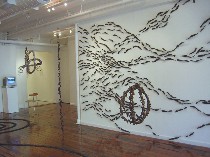 Using the individual pods that he collected in the Guyana jungle and in the Philadelphia area, Klein drew all over the gallery space. He arranged some in linear waves all over the walls. Others he strung into lianas, using them to draw in space, somehow finding remarkable variety both from the forms of the pods and the way he can make a linear lei into a thingamabob that has presence (left, front-and-center egg shape, “Kakaralli #3; below right image, “ClumpWallaba”).
Using the individual pods that he collected in the Guyana jungle and in the Philadelphia area, Klein drew all over the gallery space. He arranged some in linear waves all over the walls. Others he strung into lianas, using them to draw in space, somehow finding remarkable variety both from the forms of the pods and the way he can make a linear lei into a thingamabob that has presence (left, front-and-center egg shape, “Kakaralli #3; below right image, “ClumpWallaba”).
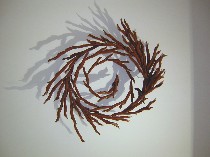 And in what I took as an act of kindness for those of us who like to touch everything that interests us, he has set out a basket of the pods to share with us just how they feel.
And in what I took as an act of kindness for those of us who like to touch everything that interests us, he has set out a basket of the pods to share with us just how they feel.
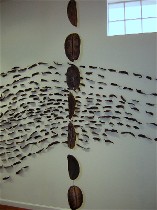 I learned from gallerist Christine Pfister that some of the jungle pods that were flat in Guyana curled up on arrival in Philadelphia, and one of the lianas stretches and contracts as the pods curl and uncurl in response to the humidity. One morning the string rests heavily on the floor, and the next, it shrinks up and swings freely (top image, farthest left vertical element, “Trysil”).
I learned from gallerist Christine Pfister that some of the jungle pods that were flat in Guyana curled up on arrival in Philadelphia, and one of the lianas stretches and contracts as the pods curl and uncurl in response to the humidity. One morning the string rests heavily on the floor, and the next, it shrinks up and swings freely (top image, farthest left vertical element, “Trysil”).
The gallery space takes on a restful quality–more spare than the jungle, but reminiscent of it. I don’t imagine the atmosphere will be the same, however, if you enter with First Friday crowds (image left, vertical element is made from jacaranda tree pods).
 The use of such a bounty of multiples reminds me of Astrid Bowlby’s collages that take over half a room, and “The River” installation by Clay Studio 1999 guest artist-in-residence Sadashi Inusuka that also took over the most part of a room. Inusuka used 800 individual clay elements plus a slurry of clay on the floor to create an impression and make a statement about preserving nature. And Bowlby’s individual elements–collaged, drawn cut-out shapes–rise into the thousands until they create a dense 3-D landscape. Although the work of the three artists seems so different, the key element of bounty and intense procreation seems to underlie all of their work (right, Bowlby’s “Yonder”).
The use of such a bounty of multiples reminds me of Astrid Bowlby’s collages that take over half a room, and “The River” installation by Clay Studio 1999 guest artist-in-residence Sadashi Inusuka that also took over the most part of a room. Inusuka used 800 individual clay elements plus a slurry of clay on the floor to create an impression and make a statement about preserving nature. And Bowlby’s individual elements–collaged, drawn cut-out shapes–rise into the thousands until they create a dense 3-D landscape. Although the work of the three artists seems so different, the key element of bounty and intense procreation seems to underlie all of their work (right, Bowlby’s “Yonder”).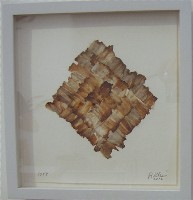 Klein also showed some small collages of used cigarette rolling paper that were beautiful and also based on multiples, to very different effect. The material, which seems like it is obsessively collected, is transformed into sepia-brown ink drawings that remind me of cedar shakes. The transformation into art has a calming effect on the material and what I imagine to be the process (image left, “1254”).
Klein also showed some small collages of used cigarette rolling paper that were beautiful and also based on multiples, to very different effect. The material, which seems like it is obsessively collected, is transformed into sepia-brown ink drawings that remind me of cedar shakes. The transformation into art has a calming effect on the material and what I imagine to be the process (image left, “1254”).
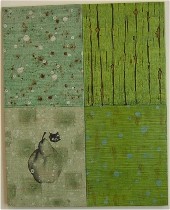 Also at Pentimenti are works by Kay Wood that have a swell sense of color. Some of her pieces, made from four smaller panels, have the feel of pieced fabric, because most of her paint has a woven look. She’s working on wood with acrylic, pencil and ink, and with collaged imagery that includes pods and pears and sea shell fossils that talk to Klein’s work in the next two rooms (image right, “Appear”).
Also at Pentimenti are works by Kay Wood that have a swell sense of color. Some of her pieces, made from four smaller panels, have the feel of pieced fabric, because most of her paint has a woven look. She’s working on wood with acrylic, pencil and ink, and with collaged imagery that includes pods and pears and sea shell fossils that talk to Klein’s work in the next two rooms (image right, “Appear”).
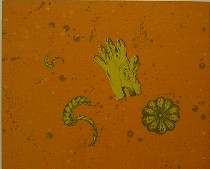 The collaged items are traces of some form of history, be it natural or personal. The personal imagery includes items like a wrinkled glove, a well-worn pair of shoes (image left, “About Time”).
The collaged items are traces of some form of history, be it natural or personal. The personal imagery includes items like a wrinkled glove, a well-worn pair of shoes (image left, “About Time”).The clothing brings some dark emotions bubbling to the top. In contrast, the four-panel, pieced together works seem like paeons to domestic peace, the natural forms recalling childhood memories. In some cases, these small hints of subject matter are barely readable beneath layers of paint, struggling to get their story out. I’m not sure they do, but the paintings are lovely to look at.









